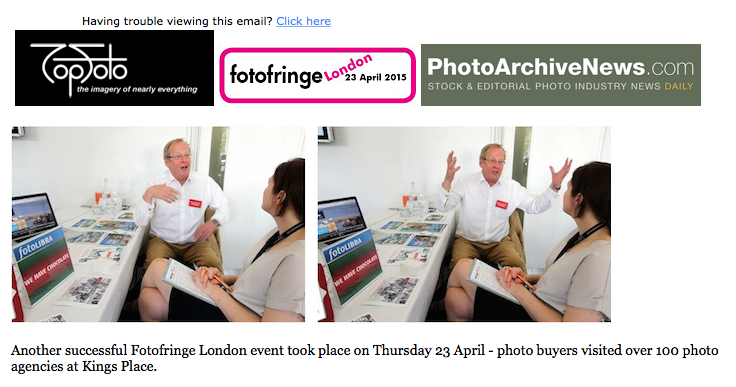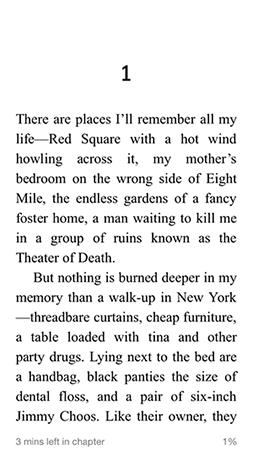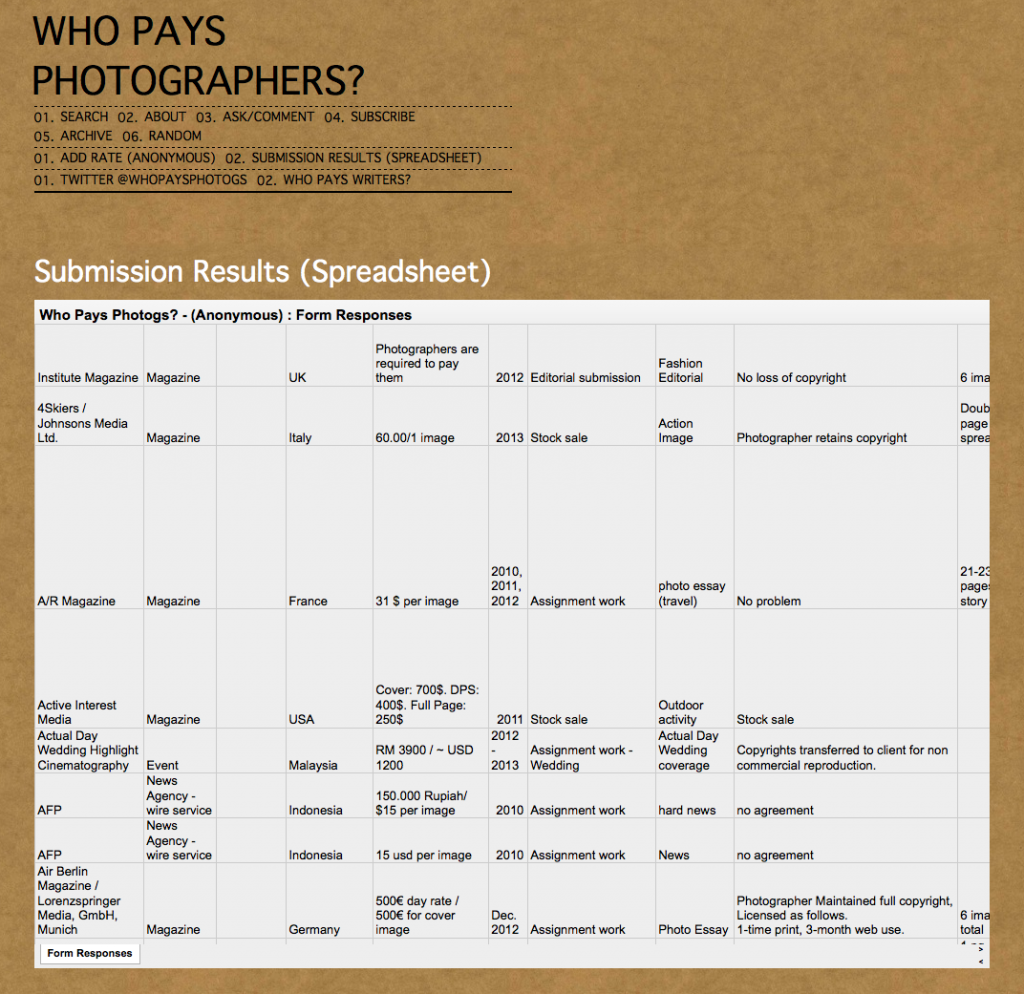How To Be Cool
April 29th, 2015Last Thursday fotoLibra exhibited at fotoFringe at London’s King’s Cross. fotoFringe is the leading picture buyers’ expo in the UK, now that BAPLA has relinquished the Picture Buyers’ Fair after losing half its members to the recession. Over a hundred picture libraries exhibited.
We only had four definite appointments booked, relying on a lot of passing trade and the fact that we were offering a huge bar of chocolate in exchange for business cards.
None of our four scheduled appointments showed up.
It would not be an exaggeration to say we were disappointed. But the following day we were pleasantly surprised to see that Photo Archive News report’s lead image featured Yours Truly in full flow with a bemused picture buyer.

However one drop-by meeting came with an interesting story. Julian Jackson, a writer and PR for green and technology businesses, recently blogged about an academic study at the University of Minnesota funded by the National Press Photographers Association (NPPA), an American professional photographers’ organisation, which showed that professional photos create much more of an impact on readers than amateur ones. They used eyetracking to get an objective measure of how long 52 people looked at photographs from newspapers and news organisations. They discovered that professionally taken photographs scored a surprising 90% more ‘eyeballs’.
Meanwhile fotoLibra’s Yvonne Seeley told me that a couple of times last week picture buyers had muttered something along the lines of “wurra wurra wanna instagrammy sorta pickcher like, wurra, innit, yoknoworramean, like.”
This is not to decry the educational achievements of picture editors, all of whom appear to have double firsts in Art History, but rather to express their embarrassment in having to ask for “poorer-quality-style” images (albeit still at 300 ppi) in order to try and attract a younger audience.
We all know about level horizons, fill-in flash, f-stop effects, exposure — but some buyers are now actively searching for converging verticals, lens flare, focus failure, in a tragic effort to capture teen spirit.
It’s doomed. As an old fart, I can tell them. I remember very clearly being a teen, and one of the things that stands out in my memory is our instant group ability to spot (and laugh at) a fake. There is nothing an elderly 25 year old could write, say or do to make us believe he or she was 18 like us. It was sad, the way they tried to be cool, to ingratiate themselves with us.
They couldn’t take our pictures. We’d know right away. And we’d pity them.
And now it seems they were barking up the wrong tree anyway, because professionally taken pictures really do attract more attention.
Don’t pretend to be cool. Do your own thing, and be cool in your own way.
So We’ll See You On April 23rd …
April 9th, 2015by Gwyn Headley
Managing Director
Coded Out Of The Marketplace?
March 5th, 2015Don’t you just hate it when the phone rings with the number “WITHHELD” and a disembodied voice (which certainly hadn’t learned English at its mother’s knee) disinterestedly interrogates you about your most intimate personal details before deigning to reveal that all they wanted to talk about was the state of your massive overdraft, which is the last thing you want to discuss?
Well I do. And what makes it even more annoying is that the traffic is always only one way. You can’t call THEM and interrogate them.
Have you noticed that broadband download speed (i.e. people selling things to you) is ten times as fast as broadband upload speed (i.e. you trying to sell your images to people)?
You can’t write to Them, either. At least I can’t. I was being unjustly bullied by a bank so I wrote to them and explained the situation. Four times. My letters were ignored. So I wrote to the Big Kahuna who at least had the grace to respond, get the situation sorted and pay me a minuscule fee in compensation before being led away in handcuffs for perpetrating financial crimes immeasurable to man.
And what has this to do with fotoLibra? Well, this morning a City firm — not a behemoth, but a known name — wanted to buy an image from us.
Let’s call the buyer Rhiannon. She finds an image she likes for a project, then finds she has to register with fotoLibra in order to buy it. Offhand I can’t think of any website that allows you to buy without asking for some form of registration.
So Rhiannon dutifully fills in our simple form and submits it.
Nothing happens.
She tries to register again. Still nothing.
Eventually she rings us up. We explain that she has to click her verification email to prove that she is who she is.
“What verification email?” She never got her verification email.
She went away to find out why. And quickly came back with the reason. Rhiannon’s coders had blocked our verification email because they had never heard of fotoLibra.com. So our confirmatory message — which she had requested — was arbitrarily dumped.
So we had to sell the picture to Rhiannon manually.
Only emails from FTSE 100 companies, Amazon, Microsoft, and other megalithic businesses appear to be allowed through. What we have to say is clearly not of interest. What hope is there for the smaller company?
We are being coded out of the marketplace.
How It Works
February 2nd, 2015by Gwyn Headley
Managing Director
If fotoLibra is informed of any unauthorised usage of a fotoLibra image by a UK limited company we will immediately follow it up with a demand for payment. If that isn’t successful, and the image belongs to one of our Pro or Platinum contributors, we will institute court proceedings.
Getty Images allow bloggers to use their 30 million images for free. We will not pursue bloggers who use watermarked fotoLibra images, but we will send a request for them to link to the original Preview image on fotoLibra.
However, the commonest misuse of watermarked images from fotoLibra is by aggregation sites. The Internet is a wondrous thing, God wot, and sometimes it will do things without reference to any human agency. Someone with a name like Dave Spart in NYC has created an aggregation site to generate stories. Its sole raison d’être is to attract humans to click on a link. That is all it does, and all it wants to do. As a result Mr Spart is now a billionaire.
What his app does is borrow, steal or create a story, usually in pictures, which then has a compelling headline added, so people are enticed to click and read it. The Mail Online loves using these. Spart then charges his advertisers per click. And he is very successful at attracting advertisers.
You’ve all seen what I mean: You’ll Never Believe What This Teenage Mom Found In Her Attic! or Awesome Landscape Photos Show Terrifying Effects Of Nature; 23 Fruits And Veggies That Practically No One Knew Existed. #5 Is Trippin’ Me Out or This Pilot Stuck His Camera Out The Window And What He Captured Will Blow Your Mind. You know the sort of thing. They Cannot Help Capitalising Every Word. And It Clearly Doesn’t Take Much To Blow A Typical Punter’s Mind.
One of the biggest click stories recently was based on a book titled “What I Eat” by Faith D’Aluisio and Peter Menzel. The writer and photographer spent four years and a million dollars researching, writing and photographing the book. It was concentrated into 20 images online, headed with catchlines like “What People Eat Around The World”, “See The Incredible Differences In The Daily Food Intake Of People Around The World” and “80 People, 30 Countries And How Much They Eat On A Daily Basis.” Spart probably made a fortune from the feature. No payment — or even credit — was made to D’Aluisio and Menzel.
Is this fair? No.
Will it be stopped? No.
Will D’Aluisio and Menzel be compensated? No.
Will Spart get richer? Yes.
Will fotoLibra pursue unauthorised image usage on our contributors’ behalf? Yes, under the terms we have described above.
Will we sue Mr Spart? No. He’s in the US, and he’s richer than us. And he is probably unaware his site is using any of our images … if it is.
I’ve never found any of our watermarked images on his site.
But I’m still annoyed!
I Am Copy Editor
October 14th, 2014by Gwyn Headley
Managing Director
Tags: American, copy editor, e-books, ebooks, English, I Am Pilgrim, Terry Hayes
During the Frankfurt Book Fair, just past, my bedtime reading was an ebook, a thriller recommended to me by Yvonne: I Am Pilgrim by Terry Hayes, whose name, bafflingly, does not appear on the cover. It’s a rollicking and undemanding read, so I recommended it to my friend and travelling companion Mike Shatzkin, who immediately bought and downloaded it.
I had been complaining of the poor editing quality of most ebooks — the Copy Editor, diligently scanning for literals, is now an extinct species in the wild — and I Am Pilgrim hits you in the first line, with a Beatles quote and a mistake:
“THERE ARE PLACES I’ll remember all my life — red square with a hot wind howling across it …”
Such a shame that people don’t seem to be bothered any more. If you know enough about style to start a chapter with the first three words in small caps, then surely you’ll know that ‘red square’ should be ‘Red Square’ — and your copy editor should be on to it like a vat of hot metal.
Mike’s version was published by Emily Bestler Books, an imprint of Simon & Schuster, whereas my British version was published by Transworld, owned by Penguin Random House. Entirely separate companies, one in America, one in the UK.
Nevertheless the fact that they didn’t exchange digital files for the ebook and each created their version from scratch somewhat surprises me. “Keep the change” is not a frequent phrase in my vocabulary, but this seems like a wanton waste of money.
Mike said “What’s the problem with Red Square? It looks OK to me.” And in his version — the American edition — it was.
The troubling thing for me is that the American typesetting is more correct than the British version. Here they are, so you can compare them:
BRITISH vs AMERICAN
Chapter One vs 1
FIRST THREE WORDS in small caps vs First three words in U/LC
space dash space vs em-dash
red square vs Red Square
8-Mile vs Eight Mile
Theatre vs Theater
burnt vs burned
Choo’s vs Choos
and I’m sure there will be examples on every page, but you get the drift.
Two nations separated by a common language, indeed.
Digital Shooting with Kodachrome and Velvia
August 28th, 2014by Gwyn Headley
Managing Director
Tags: film stock, Fuji Velvia, Kodachrome, ORWOChrom, Photoshop, plug-ins
Last night a brilliant idea came to me in my dreams. Why not program the CCD sensor in your camera to mimic the effect of your favourite film stock? (if you can remember what film was.)
As is often the case, someone else had not only had the same idea but had done something about it, and what’s more, many, many years ago and far more intelligently than me. Instead of the insanely complex reprogramming of hardware, people have created Photoshop plug-ins that can mimic the film stock of yesteryear. But by experimenting with the Channel Mixer settings, you can replicate these yourself.
Years ago I set the fotoLibra subscription level at £6 as month because that was the cost of a roll of Fuji Velvia, the finest film for recording buildings in the British countryside because it loved doing greys and greens. And that’s all I photographed really, because as you all know I am NOT a photographer, I am just a bloke with a camera.
If you went to a fairground, or visited New England in the fall, or went on a beach holiday, the Velvia would be useless. Instead you’d be taking boxes and boxes of Kodachrome, incomparable with reds and yellows and oranges.
And now there are plug-ins, or Actions, or Channel Mixer tips available for many of your favourite film stocks. To show you how they work, I’ve hacked a couple of my own images about. Criticism of my work is NOT solicited or even permitted; these are simply examples to show the effects these Channel Mixers can achieve.
I am awed by the quality of work produced by fotoLibra’s contributors, and I’m diffident about offering any hints or tips to you, but some of you may have forgotten these tricks and might enjoy playing with them.
VELVIA EFFECT USING CHANNEL MIXERS
1. Layer> New Adjustment Layer> Channel Mixer> Click OK
2. Make these changes to each of the red, green, and blue sliders for each
output channel
3. These changes are guides which you can vary, but try and make sure the Total always = +100%Output Channel: Red
> Change Red Slider to: 141%
> Change Green Slider to: -20%
> Change Blue Slider to -21%Output Channel: Green
> Change Red Slider to: -21%
> Change Green Slider to: 144%
> Change Blue Slider to -20%Output Channel: Blue
> Change Red Slider to: -21%
> Change Green Slider to: -20%
> Change Blue Slider to 144%
KODACHROME EFFECT USING CHANNEL MIXERS
1. Layer> New Adjustment Layer> Channel Mixer> Click OK
2. Make these changes to each of the red, green, and blue sliders for each
output channelOutput Channel: Red
> Change Red Slider to: 140%
> Change Green Slider to: -20%
> Change Blue Slider to -20%Output Channel: Green
> Change Red Slider to: 10%
> Change Green Slider to: 80%
> Change Blue Slider to 10%Output Channel: Blue
> Change Red Slider to: 0%
> Change Green Slider to: 0%
> Change Blue Slider to 100%
I don’t think anyone has managed an ORWOChrom effect yet but I will tell you the moment I hear about it.
The last time I had a brilliant idea in my dreams I briefly woke and wrote it down. When I awoke, the piece of paper by my bed read “Rubber Hammers”.
Hotmail and fotoLibra
August 7th, 2014This is getting beyond a joke.
Yesterday our web editor Jacqui Norman sent out a Picture Call to all our contributors. Nearly 50,000 photographers have signed up to fotoLibra since we started ten years ago. When people leave, we remove their names from our mailing list.
Yet Jacqui’s simple request for images to be purchased by a long-established and reputable British magazine, paying fair prices, has not reached 3,850 of our contributors because Hotmail has classed it as spam.
They are preventing us from communicating with members who have voluntarily signed up to fotoLibra’s services.
How can they do that?
They just can. Some Hotmail computer in Seattle noticed a small company in Britain was sending out 3,850 emails to Hotmail subscribers once a fortnight, and arbitrarily blocked it.
Nobeody read the emails. Nobody checked the content. Nobody asked the sender (that’s us) what on earth it thought it was doing, emailing nearly 4,000 Hotmail members. It just blocked us.
That’s harming its own subscribers more than it harms us, because it’s our Hotmail members who are deprived of submitting images to the Picture Call. People who use other email suppliers get to see the Picture Call, submit their images and will no doubt make sales.
But Hotmail subscribers won’t get that chance. That’s tough on them.
And exasperating for us.
Money For Photographs
August 1st, 2014by Gwyn Headley
Managing Director
Tags: Cape Town, fotoLibra, Greg Lumley, payments, photo, sales, Who Pays Photographers
Is it August already? Where does the time go? And where does the money go?
In a week where Greg Lumley, a South African photographer, made the news by offering a unique ultra-hi res print of his gorgeous photograph of Cape Town for $35,000, an influential photo magazine despondently commented that “Photography as a business is competing in a race to the bottom. Photographs are regularly devalued by people who steal them, agencies that sell them for a pittance, and photographers who are willing to work for free.”
It is very true that it’s a rough time to be in the picture sales business. Clients have lost interest in the quality of the image; their sole concern is price. National newspapers are a closed shop — management won’t allow picture desks to use anyone other than their contracted agency, unless the paper’s readers give them up for free, an acquisitions policy energetically pursued by the BBC among many others. And the agency’s photographers are up in arms because their images are being traded for pence.
Meanwhile photographers spend more and more on kit which makes their already great images even better, and still no one is buying. Tiny publishers who 20 years ago would come cap in hand for permission to buy from the lordly picture libraries now want to pay prices for RM images that you’d expect to see on a £50,000 a month contract. Mind you, they don’t get them; not from us at any rate. It’s like being bullied at school. Once they start picking on you, even the weediest gurly will fancy his chances chiz chiz.
Yesterday I came across this eye-opener of a website, Who Pays Photographers?
It’s a crowd-sourced spreadsheet of publishers around the world who pay — or don’t pay — for photography. It makes riveting, if clunky, reading. Everyone who’s ever sold a picture, or tried to, should have a look at this. And contribute, if you can.
The site owner writes: “[This is] a space to list how much — and how little — magazines, newspapers, websites, NGOs and corporations pay photographers. Editorial, commercial, advertising, entertainment — any and all presented. Listing based on anonymous submissions. This is intended as an exercise in sharing, rather than shaming — but feel free to warn your fellow photogs about deadbeats.”
The creator of this fascinating site prefers to remain anonymous, but gives credit for the idea to Manjula Martin, who devised the ‘Who Pays Writers?‘ website. I’d remain anonymous too if I came up with the bowel-tinged background colour of the site. Maybe it looks OK in Windows. It certainly doesn’t on a Mac.
I remember reading last year on several photographic forums that more than one American photographer was claiming recent $10,000 sales for book front cover image usage. But to a man they were too bashful to reveal the names of the books, the publishers, or even to show off their expensively purchased images.
Oddly, those sort of claims don’t appear on the Who Pays Photographers? site. But reports of offers of “picture credits” abound.
DON’T give your pictures away for a credit. You know what a credit is worth. As my friend Mike Shatzkin used to say, “That, and 10¢, will get you a subway token.” I’ll update him — “That, and £4.70, will buy you a tube ticket to travel the 260 metres between Covent Garden and Leicester Square.”
Shatzkin’s is pithier. Mine is scarier. But they’re both true.
Are They Free To Use?
July 4th, 2014by Gwyn Headley
Managing Director
We regularly send out mailings marketing your images to registered picture buyers. We don’t send them to people who haven’t signed up to fotoLibra, because we’re terrified of being seen as a spammer by some robot in California.
Choosing subjects is fun. Our Taxonomy Matrix (at the back of our User Manual) covers 256 aspects of life and stuff in, on and out of this planet, so we never run out of interesting and topical things to tell buyers about. Occasionally we’ll feature one of our leading photographers, and with the Tour De France starting in Yorkshire tomorrow, we thought we’d give Nick Jenkins a turn.
Here’s what we sent:
We had this reply from the Picture Editor of a famous magazine, one of the best-known and most venerable magazines in Great Britain:
They are fab – are they free to use, sorry we do not have a budget
Words failed me. So I resorted to expletives. Luckily I wasn’t allowed to reply, as I’m recovering from an op and as a result all my opinions are censored.
What do they think we are? Who do they think you are? How do they imagine we feed our little ones? I assume they all work for free and give the magazine away?
As Jesus said, the labourer is worthy of his hire, so if you missed Italian photographer Enzo dal Verme’s video in this blog post we made in May, now’s the time to watch it.














